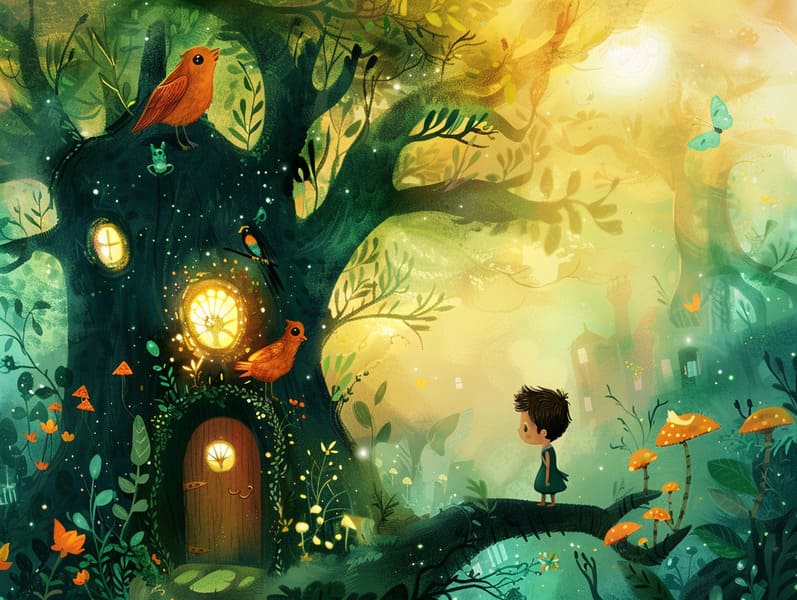The Dawn of Short Fairy Tales and Its Timeless Enchantment.
The Dawn of Short Fairy Tales and Its Timeless Enchantment.
Blog Article

Legendary fairy tales have old origins. These narratives have been whispered from one generation to the next long before they were ever written down. They were born from a variety of civilizations, including American traditions. They were initially disseminated among grown-ups, often carrying themes and messages relevant to the societal norms and beliefs of the time.
The Brothers Grimm, Jacob and Wilhelm, were among the first to compile many of these beloved stories. Their collection, "Grimm's Fables," included narratives like "Cinderella," "The Story of Hansel and Gretel," and "Little Snow White," which have since become essentials in the world of timeless fairy tales. Similarly, Hans Christian Andersen's enchanting tales, such as "The Sea Maid," and "The Little Duckling," have floated into hearts worldwide, securing their place in the pantheon of famous fairy tales.
Though they are centuries old, these stories remain as significant as ever, especially as bedtime stories for kids. These delightful tales are now available in different formats, including vibrantly illustrated books, whimsical animations, and online storybooks.
Their lasting appeal can be connected to several magical reasons:
Valuable Lessons: Traditional fairy tales often offer important moral lessons. Narratives like "The Tale of the Boy Who Cried Wolf" teach the value of sincerity, while "The Tale of the Tortoise and the Hare" point out the traits of persistence and meekness. These narratives offer the young clear distinctions between good and bad, shaping their moral compass in a soft yet impactful way.
Empathy and Understanding: Timeless fairy tales frequently portray heroines facing struggles and tests, encouraging young readers to connect with their struggles and cheer for their triumphs. For instance, "Beauty and the Beast" conveys the importance of seeing beyond the surface to know the true being of a being, encouraging perception and discernment.
Cultural Perception: Many old fairy tales are imbued with the cultural contexts from which they were born. Understanding these narratives can provide captivating looks into different societies, promoting a sense of world appreciation and comprehension.
Fantasy and Imagination: The enchanted elements in traditional fairy tales—supernatural elements—revitalize children’s dreaming abilities. These tales carry readers to extraordinary realms, motivating inventive ideas read more and a sense of delight that stays a lifetime.
Old fairy tales are not only charming but also didactic. They work as entrancing tools in enhancing various cognitive and affective skills in children. When old fairy tales are spoken, they promote language development by bringing new lexicon and elaborate sentence structures. This practice also promotes auditory perception and mindfulness, as kids concentrate deeply, prepared to see what happens next.
Furthermore, contemplating the themes and characters of timeless fairy tales can develop thinking skills and reasoning skills. Young ones are educated to discern patterns, make predictions, and comprehend cause and effect. These explorations also support the young convey their thoughts and feelings, cultivating their emotional intelligence.
In today’s modern era, the proliferation of online storybooks has made these stories more available than ever. Internet resources and digital apps share wide arrays of children's fairy tales that can be viewed or listened through anytime, anywhere. Fairy tales read aloud are particularly sought after, featuring an fun way for children to experience these charming stories. Audio stories and read-aloud videos guide characters and settings to life, often supplemented by bewitching music and instrumentals that improve the storytelling journey.
The unending appeal of traditional fairy tales lies in their ability to modify to contemporary times while holding onto their underlying messages. Contemporary revisions of these tales often include more representative figures and modern settings, making them pertinent to today’s audience. However, the essential messages of courage, charity, and honesty remain unchanged, continuing to affect children of all ages.
Fairy tales also offer a sense of coziness and homeliness. They bequeath a systematic narrative with a clear beginning, middle, and end, often finishing with the finalization of conflicts and the triumph of virtue over vice. This regularity can be solacing for kids, providing a sense of invariability in an inconstant world.
Ancient fairy tales continue to delight and instruct new generations, maintaining their mystique and applicability in modern society. As nighttime stories for kids, they render accessible a perfect blend of charm and understanding, enhancing moral values, empathy, and creativity. The existence of web-based fairy tales and the in demand status of fairy tales spoken warrant that these classic tales remain available to new generations.
By upholding and making known these narratives, we continue to laud the rich tapestry of fantasy and cultural heritage. Whether you are viewing a artistically illustrated book, perusing a internet collection, or listening on an sound book, the mystique of timeless fairy tales is always within reach. These tales emphasize of the everlasting spell of tales and its ability to hold us together across generations and cultures.
Regardless if you are reading a colorful picture book, seeing a internet library, or listening to an audio story, the splendor of popular fairy tales is always within reach.
These stories point out of the perpetual impact of narratives and its ability to unite us across eras and regions, establishing a link that enchants and educates alike.